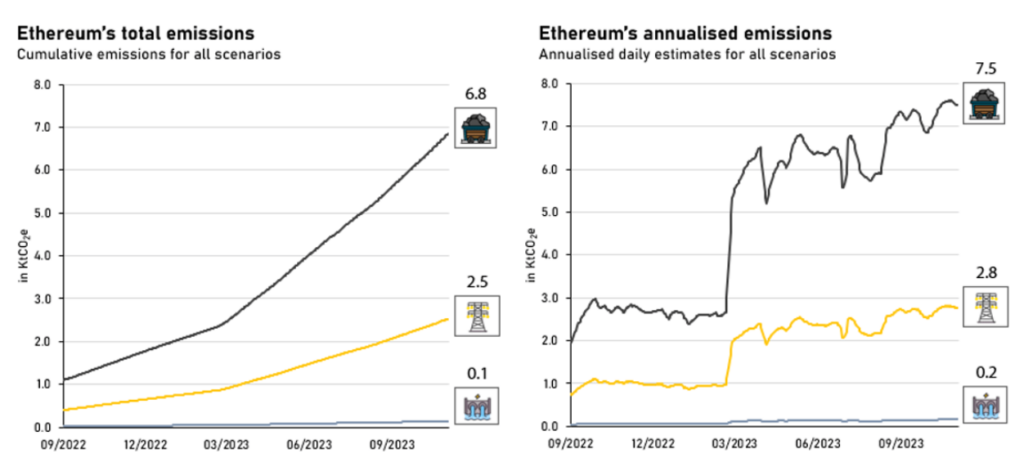- 1 The years 2019 and 2020 put a brake on a significant rise in emissions from ETH globally.
- 2 The Merge claimed to cut carbon emissions from the blockchain by 99 percent.
Since The Merge, it is believed that carbon emissions that arose while the Ethereum (ETH) blockchain was using the Proof-of-Work (PoW) consensus mechanism, have declined significantly. A new study by Cambridge Centre for Alternative Finance (CCAF), a research institute, sheds light on the carbon footprint of the second largest blockchain pre and post Merge.
The Merge Has Significantly Affected The Environmental Impact
Since its inception, Ethereum has emitted 27.5 metric tons of carbon dioxide equivalent (MtCO2e) until The Merge. Vitalik Buterin, co-founder of the blockchain, alongside many other stakeholders, claimed that the event is capable of lowering energy consumption, and in turn, carbon emissions springing out of the blockchain by over 99 percent.
The paper dubbed “Ethereum’s climate impact: a contemporary and historical perspective” says that 60 percent of them happened during 2021 and 2022. Additionally, it highlights that total emissions from the blockchain’s birth till The Merge equaled emissions by countries like Honduras and Lebanon.
The years 2019 and 2020 put a brake on a significant rise in emissions globally. In 2019, emissions were reduced by nearly 1.75 MtCO2e in contrast to last year. Furthermore, it rose by 0.10 MtCO2e the following year. This decline is attributed to low hashrate during the period.
The major change came in 2021 with hashrate soaring directly to over 7 MtCO2e and 8 MtCO2e in 2022. The paper speculates profitability in Ethereum mining could be among the reasons for a drastic change. Similar to Bitcoin (BTC) mining ETH requires lots of advanced computers running day and night to power the operations.
Additionally, CCAF charts Ethereum’s potential emissions from different energy sources. Energy generated from hydropower is charted as the least carbon-emitting source for the blockchain. It could’ve emitted 0.4 MtCO2e of greenhouse gasses (GHGs) annually. Meanwhile, coal usage could potentially have sent it to over 20 MtCO2e per year.

The Post-Merge era is a neat one given that energy and emissions have fallen significantly according to the study. Metric tons have been replaced with kilo tons. While annualized emissions from hydropower might reach 0.2 KtCO2e, coal usage would be responsible for 7.5 KtCO2e after the transition.

“Comparing the final pre-Merge GHG emissions estimate of 10.3 MCO2e with the latest post-Merge figure of 2.8 KtCO2e still reveals a significant reduction of about 99.97%, despite a substantial increase in the number of Ethereum beacon nodes” the paper reads.
It adds, “Our latest electricity mix estimate suggests that the network is now powered by nearly 48% sustainable energy (32% renewables and 16% nuclear), with wind power being the predominant renewable energy source, contributing 12%. Among the remaining 52% from fossil fuels, natural gas, coal-fired power, and oil constitute 30%, 19%, and 3%, respectively.”
Anurag is working as a fundamental writer for The Coin Republic since 2021. He likes to exercise his curious muscles and research deep into a topic. Though he covers various aspects of the crypto industry, he is quite passionate about the Web3, NFTs, Gaming, and Metaverse, and envisions them as the future of the (digital) economy. A reader & writer at heart, he calls himself an “average guitar player” and a fun footballer.


 Home
Home News
News










